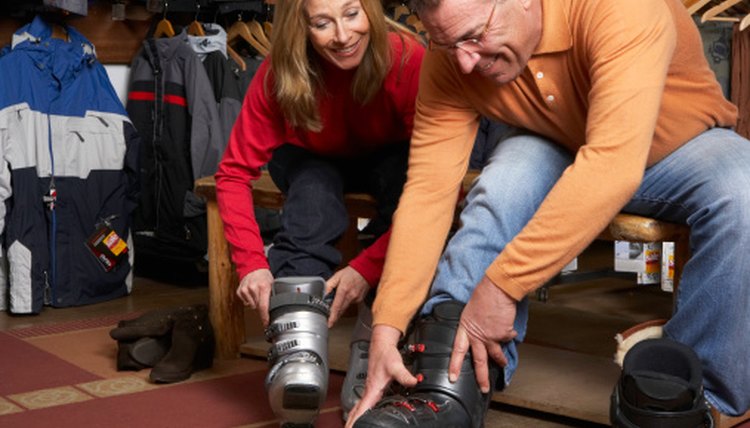Causes of Ski Boot Ankle Pain

Agonizing ski boot related ankle pain can interfere with your enjoyment of the sport. Determining the cause of your discomfort may be a complicated process. Contributing factors may include boot choice, boot fit, foot or ankle irregularities or a combination of all of the above. In some cases, your skiing technique may be the culprit.
Function of Ski Boots
Since skiing movements initiate in the feet and ankles, your ski boots are your most important pieces of equipment. The boots must be flexible enough to allow forward and lateral flexing ankle movements, but stiff enough to offer support. A boot that is too soft or too stiff for the skier's ankle strength and skill will force her to use dysfunctional ankle movements, which may eventually cause pain.
Misconceptions
Val D'Isere boot fitter Bernard Chesneau explains that many people over-tighten their ski boots for balance, but doing so creates a false sense of confidence. Chesneau argues that balance is your responsibility, not your boots. Tightening your ski boots will cut off circulation and cause cramping, which may in turn cause ankle pain.
Size Matters
The boot fitters at Inner Bootworks in Stowe, Vermont, warn that purchasing boots that are too big may also cause ankle pain. These boots may cause what they call ankle and heel slop, which means your foot is bouncing around inside the boot. Chesneau agrees, and explains that over-sized ski boots cause the ankle sits too low in relation to the boot's designated ankle pocket area. Ski turning biomechanics are compromised when the ankle does not sit in the proper position. These faulty movement patterns may cause ankle pain.
Considerations
Ski instructor Kurt Reno of Boston Mills Ski Hill in Ohio advocates smooth turn initiation as a means of preventing ankle pain. A smooth turn initiation helps skiers carve clean, controlled arcs. Abrupt initiations are jerky. They cause the skier to bang her ankles against the side of the boot, causing pain. Begin a ski turn by gently and gradually tipping your skis on to their edges.
Prevention/Solution
Most serious skiers eventually arrange for foot beds and boot alignment. Professional boot fitters take into account your foot's unique shape, and mold the boot's inner lining to a suitable shape. Skiing alignment, also called canting, corrects your actual skiing stance. Some people need more forward canting, whereas other may need to be more upright. Be ready to tell the boot fitter the types of ankle pains your are experiencing, and when you experience them.
Warning
While canting and alignment are helpful, Howard Dananberg warns that skiers should select boots suitable to their level. In an article in the December, 2002 edition of "Podiatry Today," he explains that a recreational skier who skis 15 days a year will not be comfortable in a stiff, expert boot.
References
Writer Bio
In 1999, Lisa Mercer’s fitness, travel and skiing expertise inspired a writing career. Her books include "Open Your Heart with Winter Fitness" and "101 Women's Fitness Tips." Her articles have appeared in "Aspen Magazine," "HerSports," "32 Degrees," "Pregnancy Magazine" and "Wired." Mercer has a Bachelor of Arts in psychology from the City College of New York.
